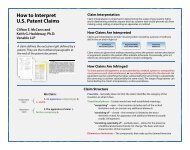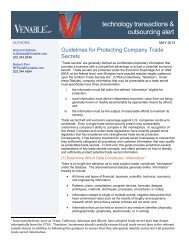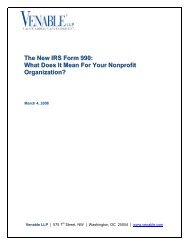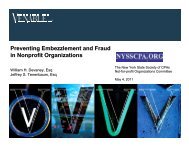F&I Menus and the Car Buyer's Bill of Rights - Venable LLP
F&I Menus and the Car Buyer's Bill of Rights - Venable LLP
F&I Menus and the Car Buyer's Bill of Rights - Venable LLP
Create successful ePaper yourself
Turn your PDF publications into a flip-book with our unique Google optimized e-Paper software.
Page 6 Transmission Monthly Legal Article (October 2006)<br />
Legal Article:<br />
F&I <strong>Menus</strong> <strong>and</strong> <strong>the</strong> <strong>Car</strong> Buyer’s <strong>Bill</strong> <strong>of</strong> <strong>Rights</strong><br />
by Aaron Jacoby, Esq. <strong>and</strong> Rob Cohen, Esq.<br />
In light <strong>of</strong> <strong>the</strong> new F&I disclosure requirements imposed by<br />
<strong>the</strong> <strong>Car</strong> Buyer’s <strong>Bill</strong> <strong>of</strong> <strong>Rights</strong> (CBBOR), finance personnel,<br />
now more than ever, are looking for ways to reduce <strong>the</strong> number<br />
<strong>of</strong> documents required during <strong>the</strong> financing process. With<br />
this goal in mind, some dealers have elected to use an F&I<br />
menu as a way to both sell F&I products <strong>and</strong> meet <strong>the</strong> itemization<br />
requirements under <strong>the</strong> CBBOR. This article explores<br />
<strong>the</strong> use <strong>of</strong> F&I menu products for that purpose.<br />
California dealers should now be fully aware <strong>of</strong> <strong>the</strong> itemization<br />
<strong>and</strong> disclosure requirements <strong>of</strong> <strong>the</strong> CBBOR (Civil Code<br />
Section 2982.2, an amendment to <strong>the</strong> Motor Vehicle Sales <strong>and</strong><br />
Finance Act). 1 Prior to <strong>the</strong> CBBOR, many dealers already disclosed<br />
F&I products on an itemized basis to <strong>the</strong>ir customers<br />
using an automated F&I menu presentation. In addition to<br />
being an effective sales presentation format, showing <strong>and</strong> <strong>of</strong>fering<br />
every product to every customer every time, an F&I<br />
menu has proven to be an effective compliance tool, negating<br />
non-disclosure claims arising out <strong>of</strong> <strong>the</strong> F&I process.<br />
Therefore, for many dealers, ra<strong>the</strong>r than improving disclosure<br />
practices, <strong>the</strong> now familiar F&I product itemization form required<br />
by <strong>the</strong> CBBOR, only added ano<strong>the</strong>r piece <strong>of</strong> paper to<br />
<strong>the</strong> deal file. For that reason, many dealers seeking to comply<br />
with <strong>the</strong> CBBOR's disclosure <strong>and</strong> itemization requirements<br />
would prefer to use <strong>the</strong>ir F&I menu system as <strong>the</strong> precontract<br />
itemization disclosure document.<br />
F&I menu products can be used to meet <strong>the</strong> CBBOR's requirements,<br />
but we urge dealers to use caution. The mere<br />
use <strong>of</strong> an F&I menu does not automatically accomplish compliance<br />
with <strong>the</strong> CBBOR. However, a properly drafted F&I<br />
menu can, when presented properly, bring you into compliance<br />
with <strong>the</strong> F&I disclosure requirements without <strong>the</strong> need<br />
for a separate products <strong>and</strong> services disclosure form.<br />
1<br />
That section <strong>of</strong> <strong>the</strong> CBBOR provides that, “Prior to <strong>the</strong> execution <strong>of</strong> a conditional<br />
sale contract, <strong>the</strong> seller shall provide to a buyer, <strong>and</strong> obtain <strong>the</strong> buyer's signature<br />
on, a written disclosure that sets forth <strong>the</strong> following information: (a) (1) A<br />
description <strong>and</strong> <strong>the</strong> price <strong>of</strong> each item sold if <strong>the</strong> contract includes a charge for <strong>the</strong><br />
item. (2) Paragraph (1) applies to each item in <strong>the</strong> following categories: (A) A<br />
service contract. (B) An insurance product. (C) A debt cancellation agreement.<br />
(D) A <strong>the</strong>ft deterrent device. (E) A surface protection product. (F) A vehicle<br />
contract cancellation option agreement. (b) The sum <strong>of</strong> all <strong>of</strong> <strong>the</strong> charges disclosed<br />
under subdivision (a), labeled “total.” (c) The amount that would be calculated<br />
under <strong>the</strong> contract as <strong>the</strong> regular installment payment if charges for <strong>the</strong> items<br />
disclosed pursuant to subdivision (a) are not included in <strong>the</strong> contract. The amount<br />
disclosed pursuant to this subdivision shall be labeled “Installment Payment EX-<br />
CLUDING Listed Items.” (d) The amount that would be calculated under <strong>the</strong><br />
contract as <strong>the</strong> regular installment payment if charges for <strong>the</strong> items disclosed under<br />
subdivision (a) are included in <strong>the</strong> contract. The amount disclosed pursuant to<br />
this subdivision shall be labeled “Installment Payment INCLUDING Listed<br />
Items.” (e) The disclosures required under this section shall be in at least 10-point<br />
type <strong>and</strong> shall be contained in a document that is separate from <strong>the</strong> conditional<br />
sale contract <strong>and</strong> a purchase order.”<br />
In order for an F&I menu to achieve compliance with <strong>the</strong><br />
CBBOR, <strong>the</strong> menu must be drafted to include a description<br />
<strong>and</strong> price for each <strong>of</strong> <strong>the</strong> following enumerated products <strong>and</strong><br />
services: (1) service contracts, (2) a debt cancellation agreement,<br />
(3) <strong>the</strong>ft deterrent devices, (4) surface protection<br />
products, <strong>and</strong> (5) a vehicle contract cancellation option agreement.<br />
(Note that insurance products must also be itemized,<br />
but, we will assume that most dealers do not sell insurance<br />
products as very few are properly licensed to do so.) Fur<strong>the</strong>rmore,<br />
<strong>the</strong> menu must present <strong>the</strong> “Installment Payment EX-<br />
LUDING Listed Items” <strong>and</strong> <strong>the</strong> “Installment Payment IN-<br />
CLUDING Listed Items.”<br />
The next generation menu s<strong>of</strong>tware must meet all <strong>of</strong> <strong>the</strong>se<br />
requirements <strong>and</strong> protect <strong>the</strong> dealership <strong>and</strong> customers with a<br />
best disclosure practices approach. Clearly, <strong>the</strong> best disclosure<br />
practice would be to set forth an itemization <strong>of</strong> ALL optional<br />
products <strong>and</strong> services sold in finance, as opposed to limiting<br />
<strong>the</strong> disclosure to those enumerated above. While not<br />
readily apparent from <strong>the</strong> plain language <strong>of</strong> <strong>the</strong> statute, it is<br />
certainly likely that <strong>the</strong> drafters <strong>of</strong> <strong>the</strong> legislation would approve<br />
<strong>of</strong> more ra<strong>the</strong>r than less disclosure (so long as <strong>the</strong> additional<br />
disclosures do not distract attention from <strong>the</strong> m<strong>and</strong>ated<br />
disclosures). In o<strong>the</strong>r words, <strong>the</strong> five-product disclosure may<br />
be viewed as only a floor ra<strong>the</strong>r than a ceiling to a dealer's effective<br />
product selling <strong>and</strong> disclosure practices.<br />
Because <strong>the</strong> law is new, we can expect some confusion surrounding<br />
<strong>the</strong> disclosure <strong>of</strong> all products <strong>and</strong> services on <strong>the</strong><br />
required disclosure form. The confusion is due to <strong>the</strong> requirement<br />
to disclose <strong>the</strong> installment payment including only<br />
<strong>the</strong> five regulated products <strong>and</strong> services as well as excluding<br />
those, <strong>and</strong> only those same products <strong>and</strong> services. Adding<br />
o<strong>the</strong>r non-regulated F&I products to <strong>the</strong> mix (as would be <strong>the</strong><br />
case with a typical menu system) changes <strong>the</strong> calculation <strong>of</strong> <strong>the</strong><br />
installment payment—adding to <strong>the</strong> monthly payment <strong>the</strong><br />
amount attributable to an item not included on <strong>the</strong> “required”<br />
list; e.g., LoJack®, which is a <strong>the</strong>ft recovery device as opposed<br />
to a <strong>the</strong>ft deterrent device. 2<br />
To avoid <strong>the</strong> potential confusion discussed above, <strong>the</strong> menu<br />
presentation <strong>and</strong> disclosure process will need to incorporate<br />
(Continued on page 8)<br />
2<br />
The CBBOR requires disclosure <strong>of</strong> a “Theft Deterrent Device” only, which is<br />
defined under Civil Code § 2981 as: “<strong>the</strong> following devices installed by <strong>the</strong> seller<br />
after <strong>the</strong> motor vehicle is sold: (1) A vehicle alarm system, (2) A window etch<br />
product, (3) A body part marking product, (4) A steering lock, (5) A pedal or ignition<br />
lock, (6) A fuel or ignition kill switch.”
SAMPLE<br />
SAMPLE<br />
SAMPLE<br />
SAMPLE
Page 8 Transmission Monthly Legal Article (October 2006)<br />
Legal Article:<br />
F&I <strong>Menus</strong> <strong>and</strong> <strong>the</strong> <strong>Car</strong> Buyer’s <strong>Bill</strong> <strong>of</strong> <strong>Rights</strong> (Cont.)<br />
(Continued from page 6)<br />
two disclosure steps on one form, one for <strong>the</strong> required product<br />
disclosures <strong>and</strong> one for all o<strong>the</strong>r products. The first step,<br />
after showing <strong>the</strong> customer <strong>the</strong> vehicle price (including <strong>the</strong><br />
price <strong>of</strong> hard accessories already on <strong>the</strong> vehicle) <strong>and</strong> finance<br />
terms, will be to itemize <strong>the</strong> regulated products <strong>and</strong> services.<br />
The customer would <strong>the</strong>n be shown in writing <strong>the</strong> effect on<br />
<strong>the</strong> monthly installment payment including <strong>and</strong> excluding<br />
those products <strong>and</strong>/or <strong>the</strong> cancellation option. The second<br />
step would be to show any F&I products that are not on <strong>the</strong><br />
“required” list on an itemized basis <strong>and</strong> to show <strong>the</strong> effect on<br />
<strong>the</strong> monthly installment payment.<br />
Included with this article (on <strong>the</strong> preceding page) is a sample<br />
menu form that complies with all aspects <strong>of</strong> <strong>the</strong> CBBOR.<br />
To flesh out <strong>the</strong> concept in step-by-step terms, <strong>the</strong> sample<br />
menu shows a vehicle price (including hard accessories not<br />
sold in finance), interest rate <strong>and</strong> term. The menu <strong>the</strong>n lists<br />
<strong>the</strong> required disclosures on an itemized basis: service contracts,<br />
debt cancellation agreement, <strong>the</strong>ft deterrent devices,<br />
surface protection products, <strong>and</strong> <strong>the</strong> vehicle contract cancellation<br />
option agreement.<br />
Next, <strong>the</strong> menu shows <strong>the</strong> sum <strong>of</strong> all <strong>of</strong> <strong>the</strong> charges disclosed<br />
<strong>and</strong> labeled as “sub-total.” Then, <strong>the</strong> amount that would be<br />
calculated under <strong>the</strong> contract as <strong>the</strong> regular installment payment<br />
if charges for <strong>the</strong> items required to be disclosed pursuant<br />
to <strong>the</strong> CBBOR were not included would be set forth, labeled<br />
“Installment Payment EXCLUDING Listed Items.” The<br />
menu <strong>the</strong>n sets forth <strong>the</strong> total monthly payment in a section<br />
labeled “Installment Payment INCLUDING Listed Items.”<br />
Below <strong>the</strong> regulated items are <strong>the</strong> non-regulated (for <strong>the</strong>se<br />
disclosure purposes) F&I products ; LoJack® would be one<br />
example. We <strong>the</strong>n include a gr<strong>and</strong> total <strong>and</strong> a total installment<br />
payment disclosure.<br />
monthly installment payment set forth on <strong>the</strong> disclosure form<br />
must be equal to <strong>the</strong> monthly installment payment shown on<br />
<strong>the</strong> customer's contract. Therefore, <strong>the</strong> dealer must ensure<br />
that <strong>the</strong> installment payment numbers are <strong>the</strong> same on both<br />
documents. That will typically mean that ei<strong>the</strong>r: a) <strong>the</strong> dealership’s<br />
DMS permits <strong>the</strong> pricing calculations to be drawn directly<br />
into <strong>the</strong> menu s<strong>of</strong>tware program, or b) that <strong>the</strong> monthly<br />
installment payment is produced by <strong>the</strong> DMS <strong>and</strong> <strong>the</strong>n manually<br />
entered into <strong>the</strong> menu s<strong>of</strong>tware program. This will avoid<br />
any minor technical errors that may result from differing calculation<br />
engines or rounding algorithms.<br />
A second caveat making matters even more difficult is that <strong>the</strong><br />
CBBOR is newly enacted in California as <strong>of</strong> July 1, 2006. As <strong>of</strong><br />
<strong>the</strong> date <strong>of</strong> this article, <strong>the</strong>re is no interpretive case law pertaining<br />
to <strong>the</strong> CBBOR, its enforceability or constitutionality.<br />
Therefore, <strong>the</strong>re is no certainty as to <strong>the</strong> final interpretation<br />
or application <strong>of</strong> <strong>the</strong> CBBOR.<br />
Dealers will need to work closely with <strong>the</strong>ir menu providers<br />
<strong>and</strong> <strong>the</strong>ir legal counsel to ensure that this next-generation<br />
process is properly designed to implement a menu system as<br />
an effective sales <strong>and</strong> compliance tool. That way, dealers will<br />
continue to be able to <strong>of</strong>fer every F&I product to every customer<br />
every time, <strong>and</strong> will be able to show that <strong>the</strong> customer<br />
knew that <strong>the</strong> product was part <strong>of</strong> <strong>the</strong> deal <strong>and</strong> elected to<br />
make <strong>the</strong> purchase. If done correctly, this will be a “best practice”<br />
that will enable <strong>the</strong> dealer to both make money <strong>and</strong> keep<br />
it.<br />
Aaron Jacoby is a partner with <strong>Venable</strong> <strong>LLP</strong>, a Washington D.C.<br />
based, national law firm. Mr. Jacoby is partner in charge <strong>of</strong> <strong>the</strong><br />
firm’s auto industry practice group, which focuses on meeting <strong>the</strong><br />
litigation, transactional <strong>and</strong> o<strong>the</strong>r legal needs <strong>of</strong> auto dealers <strong>and</strong><br />
o<strong>the</strong>r auto industry entities nationwide.<br />
There are caveats to <strong>the</strong> process. First, <strong>the</strong> monthly payment<br />
calculation can be a pitfall. Menu products <strong>and</strong> <strong>the</strong> various<br />
DMS providers may use different calculation engines that generate<br />
inconsistent monthly installment payments. To be safely<br />
within <strong>the</strong> CBBOR's disclosure requirements, pricing <strong>of</strong> <strong>the</strong><br />
Auto Advisory Services has made reasonable efforts to ensure <strong>the</strong> accuracy <strong>of</strong> <strong>the</strong> subject matter reported. AAS makes no express or implied warranty respecting<br />
<strong>the</strong> information presented <strong>and</strong> assumes no responsibility for errors or omissions. This legal article should not be used as a substitute for proper pr<strong>of</strong>essional or<br />
legal advice. If legal advice or o<strong>the</strong>r expert assistance is required, <strong>the</strong> services <strong>of</strong> a competent pr<strong>of</strong>essional should be sought.<br />
Copyright © 2006 Auto Advisory Services. All rights reserved. This publication or any portion <strong>the</strong>re<strong>of</strong> may not be reproduced, republished, stored in an electronic<br />
retrieval system, or o<strong>the</strong>rwise commercially used without <strong>the</strong> written consent <strong>of</strong> Auto Advisory Services.













